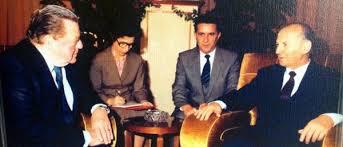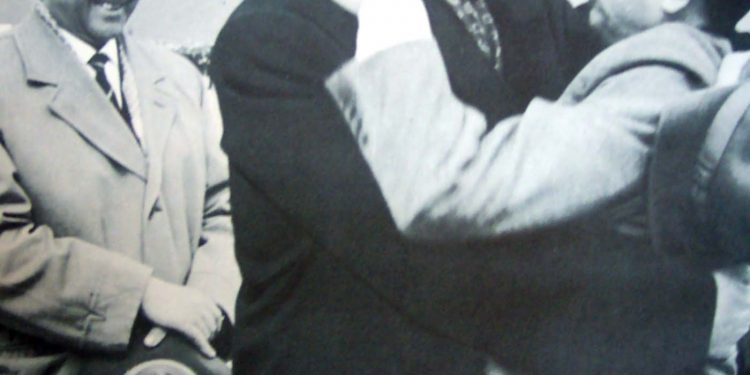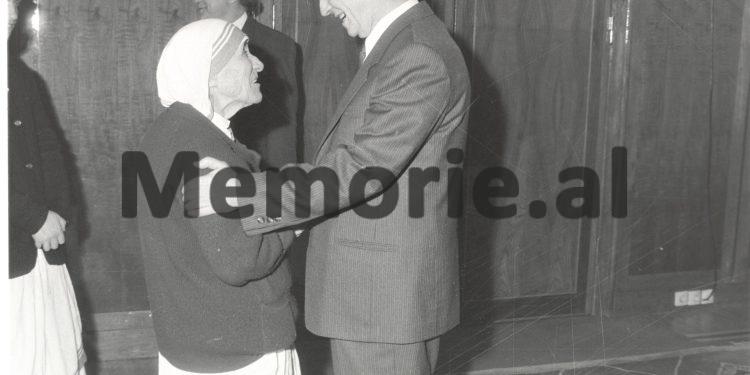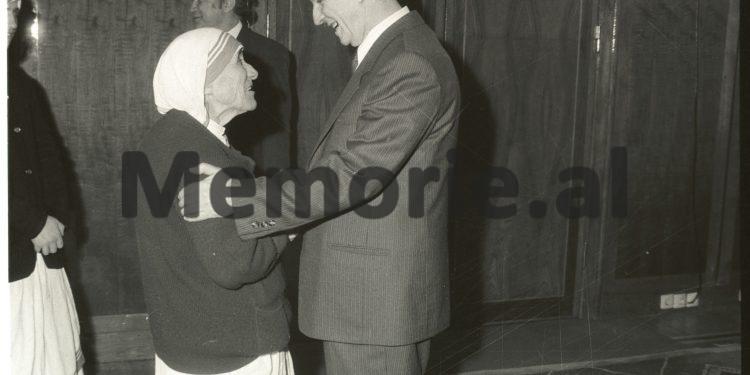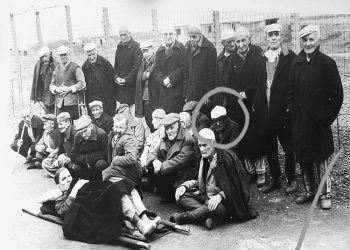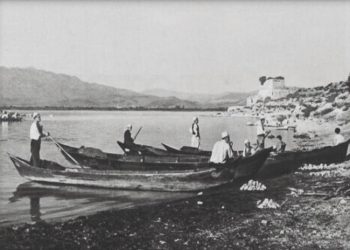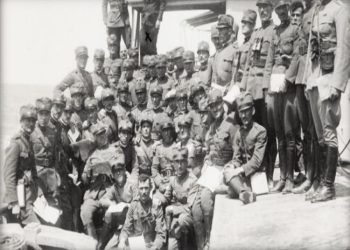Dashnor Kaloçi
Memorie.al A piece of Albanian history obsessed with celluloid, where some of the most prominent personalities in world politics visited the land of eagles ?! By Dino Grannd, Italy’s Foreign Minister who visited Tirana at the beginnings of the Zogu Monarchy, to Galeazzo Ciano, Benito Mussolini, Victor Emmanuel, Stanoje Simic, Marshall Zhukov, Khrushchev, Che Gevara, Che En Lai, Prince Sihanouk, Bavarian chancellor Strauss, Karolos Papoulias, Mother Teresa, Perez De Kuelar, Gensher, and up to US Secretary of State James Baker… ?!
Rare images of 16 personalities who visited Albania from 1930 to 1991
The first visit to Tirana by German Chancellor Angela Merkel a few years ago, among others, to the encyclopedic calendar, marked another high-profile world politics figure who trampled on the land of eagles. In these 107 years of the Albanian state, our country has been visited by some of the most prominent politicians and personalities in world politics, and most notably after the 1990s, when the communist regime fell and with it the iron curtain that separated this country from the European fraternities. From that time until today, for over a quarter of a century, many well-known names in world politics and heads of state have visited our country; Pope John Paul II, Tony Blair, Medellin Allbrigt, Colin Powell, Demirel, George W Bush, Silvio Berlusconi, Hillary Clinton, Pope Francis, Erdogan, Vuçic, etc. concluding at Chancellor Angela Merkel. But these are not the only politicians and personalities who have come to our country as friends, since from 1930 to 1991, the eagles have been visited by 16 world-class personalities, even the most prominent names. We are publishing all of these below in this post along with the related photos.
Zhou En Lai
The People’s Republic of China was to take his place after a two-year break with relations with the Soviet Union. Between the communist Albania and the Asian giant, several economic agreements were to be signed during the 1960s and 1970s that would fill the financial deficit created by the disruption of Soviet aid. For this reason, on January 1, 1963, Chinese Prime Minister Zhou En Lai would pay an official visit to Albania. As can be seen in the photo above, Çu would be warmly welcomed by Enver Hoxha himself and other members of the Political Bureau. Similar to his Soviet counterpart Nikita Khrushchev, Zhou En Lai would be greeted with ovations and cheers by curious people who had come out to watch the procession of the government escort leaving from Durres Street to Tirana’s Main Boulevard. But this visit would not be the only Chinese government number 2 in Albania. After three years and on June 24, 1966, Zhou En Lai was back for another 10-day visit. Unlike the first time, the purpose of this visit was not to strengthen economic, but ideological, relations. And this is because in China what has come to be known as the Cultural Revolution has exploded. The impact of this infamous Revolution must have been felt also by China’s distant but important partner in Europe, Albania. But unlike China the Cultural Revolution in Albania would come in the most brutal way possible, severely damaging religion, art, culture, and an entire intellectual caste.
Samde Norodom Sihanouk
After Çu En Lai, another Communist leader would visit Albania. It is about the Prince of Cambodia, Norodom Sihanouk and Princess Monica, who would visit Albania full-time five times during the 1970s. The Communist leadership itself would stage a large banquet in the lobby of the Palace of Brigades on February 20, 1976, the day of the Sihanouk couple’s arrival, as shown in the picture clearly showing Prince Norodom talking to Enver Hoxha. But the Prince of Cambodia’s visit to Tirana would not be a courtesy visit. It was the time when left-wing extremists called Red Khmer led by dictator Pol Pot would overthrow the communist but liberal Monarch to turn the exotic state of Southeast Asia into a giant human slaughter where until 1979 they would lose the lives of about 2 million Cambodians. That is why Norodom Sihanouk and Monica, in exile this time, would embark on a worldwide tour to secure possible political and economic support from all countries. One of these would be Albania. For Hoxha himself, it would be the first and last time to assist in the expectation of any royal couple, as official Tirana was known to be a sworn opponent of any monarchy in the world, whether liberal or not.
Franz Joseph Strauss
After almost 43 years since the remote May 10, 1941, when a top Western state leader such as Victor Emanuel III would visit Albania, the Chancellor of Bavaria and one of Germany’s most influential politicians Franz Joseph Strauss, along with his son Max, would come to Greece by surprise for an official courtesy meeting in Tirana. After collapsing with China in 1978, Communist Albania had begun to feel strongly the imminent economic collapse, which would make Hoxha embark on efforts, albeit lukewarm, to head west. But for health reasons (7 months after Hoxha would die) the Bavarian Chancellor would be hosted by the Political Bureau No. 2 and future communist leader of Albania Ramiz Alia. Strauss would come to Tirana on August 21, 1984, and after that visit he would come back twice in 1985 and 1986. The Albanian side’s response to economic openness to the West would be a ” NO ”cut. But four months after the death of dictator Hoxha, Joseph Strauss would come again to meet President Alia. Again, the Albanian side’s response to a political and economic orientation towards the West and specifically to Germany would be negative. It should be the third time that Franz Joseph Strauss has received a somewhat positive response to a possible political and economic opening to Germany by Albania. But by this time Hoxha had been dead for a year and a half, and Alia would have been forced to pursue a more liberal official policy. The photo corresponds to the third Alia-Strauss meeting at the Presidency building in 1986, the year in which Albania would re-establish economic and diplomatic relations with Federal Germany.
Karolos Papoulias
November 1987 would set a new record in Albania-Greece bilateral relations. It would be the first time a senior Greek statesman has visited Albania since the inspection of Greek troops in southern Albania by King Constantine in 1917 (if it can be called a visit). Greek Foreign Minister Karolos Papoulias would pay a five-day visit to Albania today, not forgetting the Greek minority in the southern border areas, as described in this photo celebrating with a group of sympathizers in the village of Voshtina in Dropull area. The visit of Greek diplomat Papoulias would launch a new era in the often strained relationship between Tirana and Athens. Papoulias would meet with top Albanian leaders such as President Alia, Prime Minister Carcani and his counterpart Malile. But one thing that struck the Albanian side and the protocol was the visit that the Greek foreign minister paid to his home in Fier, a former childhood friend, Fuat Boçi, the humorous actor of that city who was then widely known by the name of a role: Lipe Shtogu. Papoulias himself would return to Albania this time as President of Greece in May 2014, where he would discuss hot Albanian-Greek topics with key Albanian policy leaders.
Mother Teresa of Calcutta
Another world-famous figure would visit Albania on August 1-15, 1990. It is precisely the prominent humanist of Albanian origin, Anjeza Gonxhe Bojaxhi, also known as Mother Teresa of Calcutta. Mother Teresa’s visit took place at a very significant moment for the Albanian state and society, as the first signs of political and economic pluralism had just begun to emerge. But unlike all the other visits of other dignitaries who have visited Albania over the years, there is no doubt that Mother Teresa’s case is definitely the most tragic and the most painful. And that was after Mother Teresa herself through a diplomatic lobby around the world had formally requested to visit Albania and meet Mother Drane and her sister Agen, who were ill. Mother Teresa herself, through the mediation of many world-famous personalities but also with the help of the Vatican, tried to persuade Enver Hoxha to stay with her ailing family for a week. But Hoxha reacted sharply by not granting her a residence permit in Albania. Mother Draneja and her sister Ageja would have died in 1972 and 1973. But Mother Teresa would return to Albania in August 1990, making a very startling and significant gesture to the time. She also had meetings with President Alia and the family of dictator Hoxha, as shown in the photo. But the most poignant part of her two-week visit to Albania would undoubtedly be the moment she laid a bunch of flowers at Enver Hoxha’s grave to prevent the man from seeing her family for the last time. The gesture would be very significant. It would eventually seal the absolute superiority and compassion of religion in Albania over the most anti-religious regime in the world.
Javier Peres de Cuellar
1990 would be a hopeful and significant year for Albania’s efforts for a final divorce with the communist regime. The fall of the Berlin Wall and the collapse of communist regimes throughout Central and Eastern Europe had greatly shaken the communist regime of Tirana. For this reason, the UN decided to send to Albania a brief but significant visit to its head, Peruvian Javier Peres de Cuellar. De Cuellar would come to Albania on May 12, 1990, and demand a meeting with Ramiz Alina on behalf of the world’s most important political and economic body to discuss Albania’s immediate economic opening with the West. to avoid a humanitarian catastrophe as well as Albania’s full political and diplomatic orientation with Europe and the United States of America. Recognizing the extremely draconian nature of the Albanian communist regime, Javier Perez de Cuellar demanded a strong assurance from Alia that the Albanian State would do its utmost to effect a smooth political and economic transition of the country so that Albania would not return to a second Romania in the Balkans. But film and photographic images are scarce in this meeting as it took place in a relatively short time. The photo in question shows Javier Perez de Cuellar during his visit to Tirana (pictured closely). Two months after the hopeful visit of the UN head, what would be called the July 1990 Embassy Crisis in Tirana would explode.
Hans Dietrich Genscher
After the visit of the Chancellor of Bavaria Franz Joseph Strauss to Albania another prominent German politician would come to a critical moment in our country. Hans Dietrich Genscher, Vice Chancellor of Germany and at the same time Foreign Minister, would arrive in Albania on June 15, 1991, when the communist regime was practically living in the last days. Genscher would hold bilateral meetings with President Alia (as pictured above) and with Prime Minister Ylli Bufi. The moment Genscher came to Albania would undoubtedly be one of the most difficult political and economic times in Albania, having just emerged from the 47-year-old communist system. It would be Germany that would play a key role in launching Albania’s integration and democratic processes with the European Union.
James Baker
After almost 45 years since the departure of English and American missions from Albania in November 1946, Democratic Albania was visited by US Secretary of State James Baker, Democratic Party No. 2. Baker’s visit would undoubtedly be one of the most exciting moments for one of the world’s most influential personalities in the country until that year’s most anti-American in the world. The Communist dictatorial regime for 47 years had rooted in an aggressive anti-American ideological policy where the US was conceived as one of the most aggressive and negative states in the world. But official Communist policy absolutely could not have eradicated the pro-American sentiment of the Albanian people over the years. And this was best shown in the grand reception that 200,000 people made to Secretary of State James Baker at Scanderbeg Square (as highlighted in the photo below). Baker himself met with Prime Minister Ylli Bufi, opposition leader Berisha etc, as well as senior members of the Albanian democratic government. Baker’s visit itself would be the clear final message that Albania was once and for all divided by the Communist regime and that its official policy would continue to be directed only by the United States of America and Western Europe. James Baker would conclude his famous rally in Tirana in front of thousands of spectators with the expression “Albanians, freedom works, trust it”.




